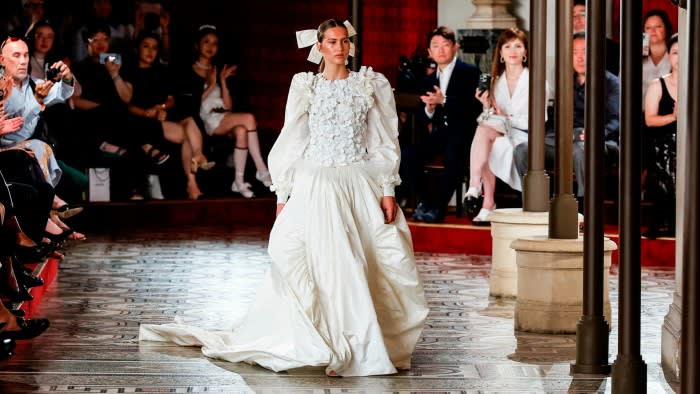Unlock the Editor’s Digest for free
Roula Khalaf, Editor of the FT, selects her favourite stories in this weekly newsletter.
Walk down Bond Street past the luxury brand shops and you know instantly the prices are going to be steep. First, they are not shown in the window. And second, there is often a hefty bouncer on the door who looks like he’s there to review your bank balance before you are even allowed to step over the threshold.
Comedian Harry Enfield once parodied the clientele who frequented a Notting Hill antique dealership with his “I saw you coming” sketches.
The perception is that the rich are an easy mark: you can charge them what you like, they are gullible and, often, stupid enough to pay it.
To investors, this is an appealing quality among a business’s customer base. Luxury brands have been a mainstay in many investment funds over the years because they have been able to dial up their prices seemingly without customers noticing. So they are seen as reliable earners and a good inflation hedge. Many of these companies can make gross margins of over 80 per cent.
But if it was ever really that simple, it is certainly not now.
The rich are revolting. And not just the rich. Many of the aspirational middle class — those who had on their bucket list to own a Chanel 2.55 handbag, a Porsche 911 or an Omega Speedmaster watch one day — are now asking: is it worth it? This may have implications for your portfolio.
The story probably starts with the end of the pandemic and “revenge spending”. People were just happy to be alive and free again. They had been entertaining themselves during lockdown scrolling on their smartphones, drooling over luxury watches or long-admired handbags. They had pent-up savings.
It was time to spend, spend, spend. With demand soaring, many manufacturers raised their prices. Luxury watch prices typically rose 20 per cent in the fourth quarter of 2021. Old and rare whiskies went up even further. We saw the same in other markets.
It was good for a while, reflected in share prices generally. Between the end of March 2020 and the end of November 2021 the S&P Global Luxury Index rose 135 per cent. But the companies that used the post-pandemic rush as cover to raise prices beyond inflation — and without necessarily offering customers more value — are now facing a backlash.
Some would say the best illustration of this is Chanel, which increases its prices twice a year. Its iconic medium classic flap bag has doubled in price since 2016. The company’s chief executive, Leena Nair, has blamed the price increases on the cost of raw materials.
Mulberry is a cautionary tale. It is a great British brand — a reference point for the aspirational middle class. It hired former Hermès executive Bruno Guillon as chief executive who proceeded to take Mulberry upmarket and raised prices. But the way Hermès achieved its status was through close to 200 years of investment — not by jacking up prices in short order. Mulberry lost many core loyal customers. During his tenure, which ended in 2014, the shares lost nearly two-thirds of their value — and they have never recovered.
I should stress that it is not that the rich are unwilling to spend if they see value in what they are being offered. Hermès has not raised prices excessively. One could say this is because its average prices are sufficiently high already. Even so, it appears to have shown restraint in the context of the rarefied universe in which it sits. Hermès saw turnover rise 15 per cent last year, and in the past 12 months its share price is up nearly 10 per cent.
Another winner is Ferrari. Its revenue in the first quarter was nearly 11 per cent up year-on-year (though selling pretty much the same number of cars), and its profits were up nearly 15 per cent. Its shares have risen 40 per cent in the past 12 months. It has increased prices, but is improving its offer to customers through things like greater personalisation. This is in addition to its secret sauce — keeping supply well below estimated demand, in keeping with its founder Enzo’s oft-repeated quote that he “would always produce one less Ferrari than the market demands”.
Emerging price sensitivity also presents an opportunity further downstream. Take the tequila drinks market. During and after lockdown there was a surge in demand for Don Julio 1942 tequila. A bottle will set you back more than £150.
Suffice to say that interest in premium-plus tequila has waned somewhat as the cost of living has taken its toll. Sales of Espolòn tequila, at about £30 a bottle, are soaring. You can buy tequila for a lot less than £30, of course, so it would be harsh to call Espolòn the Lidl of the tequila world. But it is perhaps the equivalent of UK shoppers moving from Waitrose to Tesco.
In short, then, the relationship between brands and consumers is now less one-sided than it was in the wake of the pandemic. In Italy, home to some of the world’s great brands, there is a saying that describes this power balance. Loosely translated, it is: “We’re both holding a knife, but one of us has their hand on the blade”. Many brands no longer have such a strong grip on the handle.
The lesson for investors is that we cannot blindly assume that strong brands have unlimited pricing power. Beyond a certain level, pricing power becomes pricing privilege — companies have to earn the right to raise prices further by enhancing value in some way. The good news is that those that do are gaining share at the expense of those that cannot. Do your research well, and therein lies opportunity.
Swetha Ramachandran is a global equity manager at Artemis


